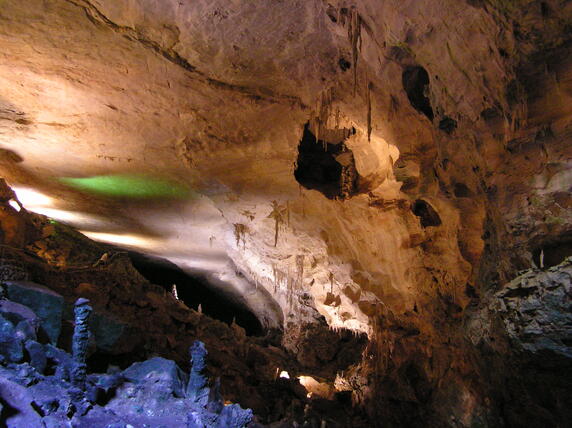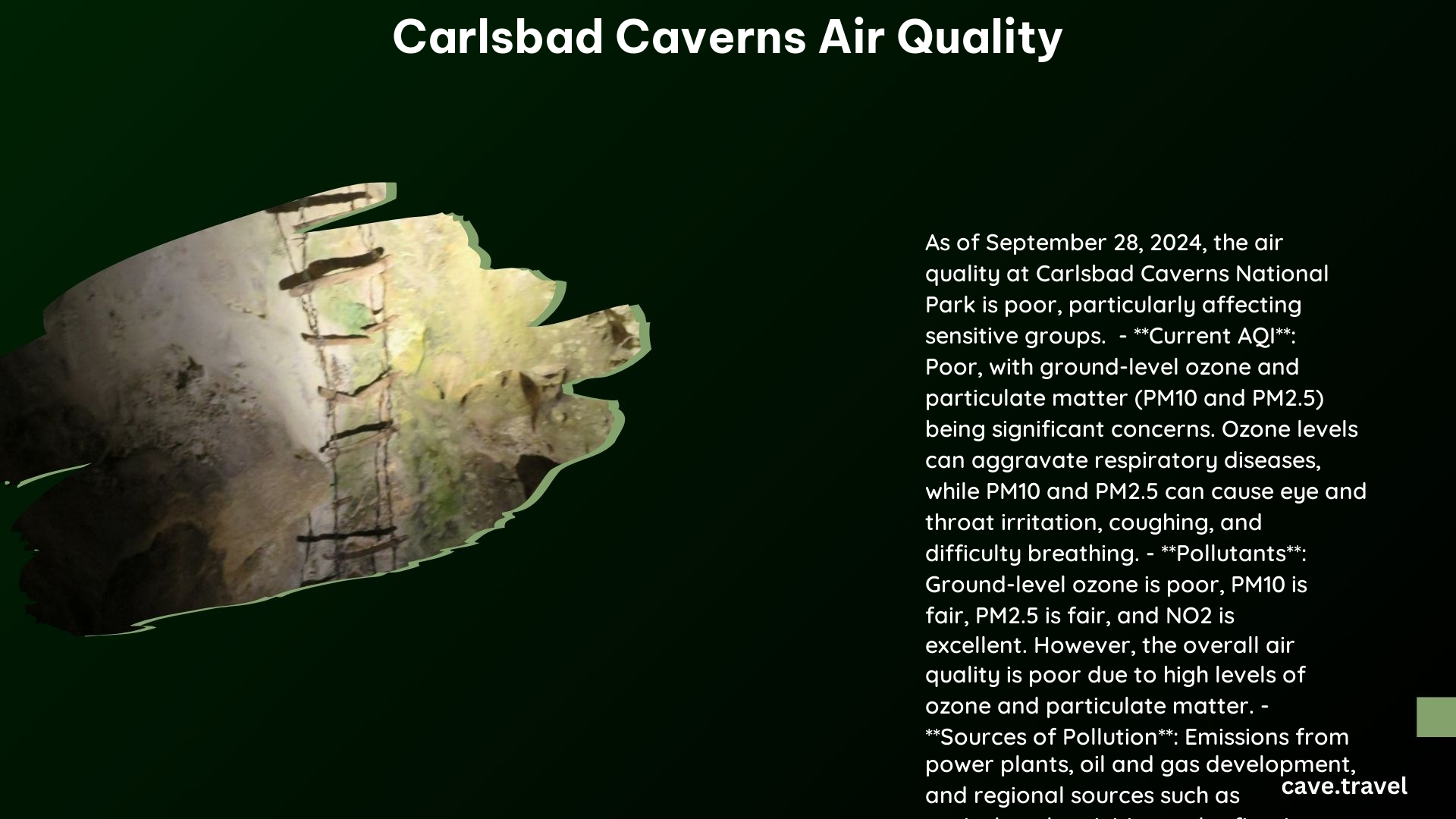Carlsbad Caverns National Park faces significant air quality challenges due to nearby oil and gas development in the Permian Basin. Ozone levels frequently exceed EPA standards, particularly during summer months. The park’s air quality is classified as poor, with high levels of pollutants like ground-level ozone and particulate matter. This pollution primarily stems from oil and gas production activities, impacting both the environment and visitor health.
What Are the Current Air Quality Conditions at Carlsbad Caverns?

The current air quality at Carlsbad Caverns National Park is a matter of serious concern. Recent reports indicate:
- Air Quality Index: Classified as “poor” for several consecutive days
- Ozone Levels: Frequently exceed the EPA health standard of 70 parts per billion (ppb)
- Impact: Unhealthy conditions, especially for sensitive groups
This poor air quality is largely attributed to the extensive oil and natural gas development in the nearby Permian Basin. The emissions from these industrial activities significantly contribute to the degradation of air quality within the park.
How Do Pollution Levels Vary Throughout the Year?

Pollution levels at Carlsbad Caverns exhibit seasonal variations:
- Summer Months:
- Highest ozone concentrations
- Frequent exceedances of EPA health standards
-
Increased risk for visitors and local ecosystems
-
Winter Months:
- Generally lower pollution levels
-
Reduced ozone formation due to less sunlight
-
Year-round Concerns:
- Consistent presence of pollutants from oil and gas activities
- Ongoing impact on park’s air quality regardless of season
What Are the Primary Sources of Air Pollution at Carlsbad Caverns?
The air pollution at Carlsbad Caverns primarily originates from:
- Oil and Gas Development:
- Drilling operations
- Natural gas flaring
-
Equipment emissions
-
Vehicle Emissions:
- Increased traffic in the Permian Basin region
-
Emissions from both personal and industrial vehicles
-
Industrial Activities:
- Processing plants
- Storage facilities
- Transportation of oil and gas products
These sources release significant amounts of:
- Nitrogen oxides (NOx)
- Volatile Organic Compounds (VOCs)
- Particulate matter
Together, these pollutants contribute to the formation of ground-level ozone and overall poor air quality in the park.
How Does Air Quality Impact Visitor Experience?
The poor air quality at Carlsbad Caverns can significantly affect visitor experience in several ways:
- Health Concerns:
- Respiratory issues exacerbation
- Increased risk of asthma attacks
-
Throat irritation and headaches
-
Visibility Reduction:
- Hazy conditions obscuring scenic views
-
Diminished enjoyment of park landscapes
-
Activity Limitations:
- Advisories against strenuous outdoor activities on high pollution days
-
Potential closure of certain areas during extreme air quality events
-
Educational Impact:
- Altered ranger programs to address air quality issues
- Increased focus on environmental awareness among visitors
What Measures Are Being Taken to Monitor and Improve Air Quality?
Efforts to monitor and improve air quality at Carlsbad Caverns involve multiple approaches:
- Continuous Monitoring:
- Ground-based measurement stations
- Satellite data from NASA’s TEMPO instrument
-
Hourly daytime scans of North American atmosphere
-
Collaborative Research:
- Partnerships with universities and research institutions
-
HEI Energy study collecting data multiple times daily
-
Modeling and Analysis:
- Use of advanced models to understand pollutant dispersal
-
Source attribution studies to identify major contributors
-
Policy Advocacy:
- Engagement with local and federal authorities
-
Push for stricter regulations on oil and gas emissions
-
Public Awareness:
- Educational programs for visitors
- Regular updates on air quality conditions
How Does Indoor Air Quality Compare to Outdoor Air in the Caverns?
While specific data on indoor air quality within Carlsbad Caverns is limited, several factors influence the air quality inside the cave system:
- Natural Filtration:
- Cave systems can act as natural filters, potentially improving air quality
-
Limestone formations may absorb some pollutants
-
Limited Ventilation:
- Restricted air exchange with the outside environment
-
Potential accumulation of certain pollutants over time
-
Human Impact:
- Visitor breath and movement can affect CO2 levels
-
Artificial lighting and infrastructure may introduce additional pollutants
-
Temperature and Humidity:
-
Stable cave environment may influence pollutant behavior differently than outdoor conditions
-
Monitoring Challenges:
- Difficulty in conducting comprehensive air quality studies within the cave system
- Need for specialized equipment adapted to cave environments
While the indoor air quality may differ from outdoor conditions, it’s likely that the overall poor air quality of the region still impacts the cave environment to some degree.
What Are the Long-term Implications of Poor Air Quality for Carlsbad Caverns?
The persistent poor air quality at Carlsbad Caverns poses several long-term risks:
- Ecological Impact:
- Damage to native vegetation
- Alteration of soil chemistry
-
Potential disruption of cave ecosystems
-
Cultural Resource Degradation:
- Accelerated weathering of rock formations
-
Potential damage to prehistoric cave drawings
-
Tourism and Economy:
- Reduced visitor numbers due to health concerns
-
Negative impact on local tourism-dependent businesses
-
Park Management Challenges:
- Increased need for air quality mitigation measures
-
Potential restrictions on park activities and access
-
Public Health Concerns:
- Long-term health risks for park staff and frequent visitors
-
Broader regional health implications
-
Policy and Regulatory Pressure:
- Increased scrutiny of regional industrial activities
- Potential for stricter environmental regulations
Addressing these long-term implications will require sustained efforts from park management, local industries, and policymakers to improve air quality in and around Carlsbad Caverns National Park.
References:
- https://phys.org/news/2024-05-nasa-high-quality-real-air.html
- https://www.accuweather.com/en/us/carlsbad-caverns-national-park/88220/air-quality-index/21819_poi
- https://engr.source.colostate.edu/researchers-highlight-oil-and-natural-gas-development-in-permian-as-key-source-of-ozone-pollution-in-carlsbad-caverns-national-park/
